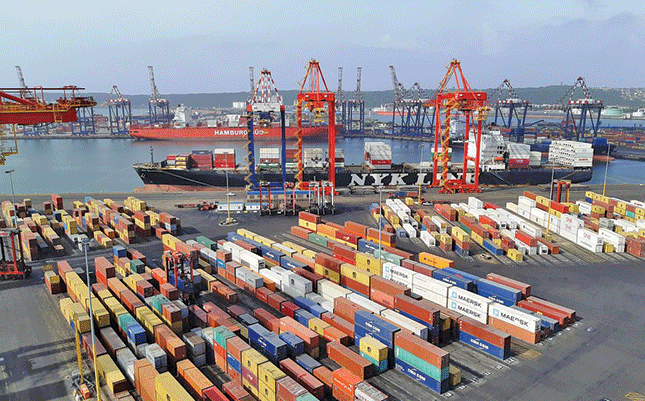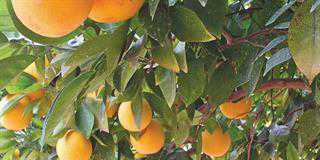
Photo: Supplied
South Africa’s agriculture sector has proven remarkably resilient in the face of numerous difficulties, from erratic weather and increasing input costs to service disruptions.
Unfortunately, a potentially crippling challenge has been added to this already formidable list: the parlous state of the country’s infrastructure.
South Africa’s ports have been making headlines as cyberattacks, ageing infrastructure, and mismanaged funds have left export crops high and dry. Since the foreign income earned from these crops are what make the sectors viable, the lack of reliable logistics places rural economies at risk.
To take one example, as the citrus industry continues on its growth path, the revenue that it is set to earn in future will depend on the infrastructure put in place, maintained and upgraded today. However, this is now in jeopardy, given Transnet’s recent announcement that it does not have the funds to carry out the crucial maintenance needed to keep South Africa’s ports operating properly.
The problem does not stop with the ports. Crops are threatened directly due to deteriorating irrigation systems and poor water management. Congested, potholed roads and the lack of an efficient rail system make it difficult and expensive for farmers to transport their produce to the nearest port.
Kulani Siweya, an agricultural economist at Agri SA, points out that the crisis has been long in the making: “Burdened by historical blockages and weaknesses, successful infrastructure investment has been hindered, bringing us to where we find ourselves today.”
Bumps in the road
Siweya emphasises that most farming activity takes place in rural areas, and the lack of road maintenance in these parts undermines the viability of the sector.
“This is particularly the case when you consider that the [farming] sector transports more than 75% of its produce by road.
“[In addition], although the road freight industry is a private sector success story, with high levels of efficiency and flexibility to meet market demand, it’s burdened by excessive administration costs, such as fuel, wages, licence fees, rates, excise duties, interest rates, tolls and taxation. Furthermore, the current national and provincial administration of this complex freight transport sector is suboptimal.”
A recent report by Business Leadership South Africa (BLSA) notes that most infrastructure in the country suffers from maintenance backlogs, causing frequent breakdowns and disruptions. The report states that, according to the Committee of Transport Officials’ 2014 estimate, South Africa’s 750 000km of roads have a maintenance backlog of R197 billion.
However, this figure was challenged and put closer to R410 billion in 2018.
“Infrastructure investment has fallen sharply over the past six years, from 20,3% of GDP in 2015 to 17,9% in 2019, far from the National Development Plan’s target of 30% of GDP. The decline has been particularly evident in public sector spending, with both state-owned enterprises and main budget spending on infrastructure falling from 7,3% of GDP to 5,4% over the same period. The public infrastructure investment that has been undertaken has often delivered poor value for money,” states the report.
The effect on exports
South Africa’s lack of global competitiveness has often come under fire, and a recent report on container port performance shows that the country’s ports do nothing to improve the situation.
The World Bank and IHS Markit’s Global Container Port Performance Index shows that South Africa’s ports in Cape Town, Gqeberha, Durban and Coega are some of the poorest performers in the world, operating at only 30% of international norms. Put another way, they load and offload containers at less than a third of the rate expected internationally.
Siweya adds that World Bank reports have also shown that South Africa’s ports are expensive and inefficient.
“Defective planning, poor management, and inefficiencies caused by spatial limitations and [the poor condition of equipment] all result in bad service delivery. Corruption and the use of port revenues to cross-subsidise other Transnet activities have now resulted in the need for significant investment.”
Few agricultural industries have been as hard hit by the inefficiency of ports as citrus. According to Mitchell Brooke, logistics development manager at the Citrus Growers’ Association of Southern Africa, Transnet could be the biggest threat to the fruit export industry.
“Transnet is in a rapid state of decline. Operations at the port authority and terminals division have deteriorated so severely that we’re now witnessing massive delays to ships calling at South African ports. [And the present issues go way beyond] the disruptions caused by the COVID-19 pandemic in 2020, the recent looting in KwaZulu-Natal and the cyberattack on Transnet’s IT systems in July 2021.
“Transnet has been a subject of mass corruption as a result of state capture. Millions of rands have been embezzled from Transnet, and the company has conceded that it doesn’t have enough capital, or access to capital, to inject into the business to sustain its operations.
“During the period of state capture, capital that should have been allocated to obtain or replace items such as ship-to-shore cranes, straddle carriers, reach stackers and so on, disappeared. Maintenance and midlife refurbishment of the machinery and equipment at ports were also mostly ignored.
“So in essence, what we’re finding is that the machinery and equipment in place to service the ports cannot do so adequately,” says Brooke.
The country’s reputation as a supplier of quality export fruit is increasingly at risk, because fruit is spending more and more time at ports as a result of delays.
Brooke explains that a ship can spend days or even weeks lying at anchor before being processed at a South African port of call. In some cases, months may pass before a ship can depart South African waters after visiting the country’s ports.
“This has led to shipping lines pulling services from some of the ports and in many cases omitting to call at ports due to the severity of the delays that ships encounter.”
He notes that the poor state of Transnet’s operations seriously compromises South Africa’s agriculture and manufacturing sectors.
“This poses a huge threat to the local economy. Businesses have lost and continue to lose millions of rands as manufacturing and production plants have had to stop [their work] due to the backlog in supply of components. And then there are the losses the fruit export industry is facing as a result of the additional costs of logistics and the compromised quality [of fruit] due to high dwell times.”
Irrigation issues
The neglect of water supply infrastructure is another aspect that is bedevilling South African agriculture. While there is ample evidence to suggest there are problems with this infrastructure, little research has been done to evaluate its extent.
Prof Ferdi Meyer, managing director of the Bureau for Food and Agricultural Policy (BFAP), describes the infrastructure as being in a very poor state.
“Bulk infrastructure channels and everything that takes water to the farm gate is problematic. The Water Research Commission estimates that around 50% of water is lost between where it is extracted from the dam to where it enters the farm. These losses are allocated to agriculture, so while the water footprint looks high, far less is actually being used to grow food.”
He notes that leaking pipes and broken pumps are of particular concern.
“We’re far behind on infrastructure maintenance and improvements. Water outages will become the new load-shedding, and we’ll experience more issues with the consistent supply of fresh, clean and safe water for farming and city communities.”
As an example, the infrastructure of the irrigation schemes in the Hartbeespoort, Douglas and Vaalharts areas is nearly 85 years old. They currently service vast tracts of productive farms that are crucial to South Africa’s food supply, and are in desperate need of maintenance.
Meyer adds that idle irrigation schemes are also a major problem. “We estimate that over 50 000ha of irrigation schemes are not functioning. In Makatini Flats [in KwaZulu-Natal], this is mostly as a result of political infighting. Areas like this have so much wasted potential.”
To reduce their reliance on water, farmers are employing water-saving techniques such as moisture probes and drip irrigation. Meyer says that while these go a long way towards making do with less, South Africa has much more potential to plant high-value crops. But to do this, water needs to be better managed by government.
“Government’s Infrastructure Master Plan needs to be implemented so that we have a strategic plan. A lack of funding for the improvement of the water systems is a big challenge, but one that government can’t shy away from, considering the importance of water.”
With the proper management of water, Meyer estimates that the 50 000ha of idle irrigation schemes could become productive. “Herein lies a big opportunity to alleviate poverty, as it will allow access to food for households in these poor communities, as well as sufficient surplus for local and export markets. [Producing] high-value crops will bring jobs and income.
But these tend to be more [technically challenging] crops, and we’d need to have adequate education systems in place to make a gradual switch from grains to crops such as citrus and blueberries.”
The way forward
Given the mammoth task that lies ahead in resolving these infrastructure problems, public-private partnerships will be crucial.
Siweya believes that it is only through private investment that infrastructure targets can be achieved.
“Over-reliance on government creates inefficiencies. We therefore need the involvement of the private sector to enable broad infrastructure procurement, which will set the country back on the correct trajectory.”
BLSA says private-sector investment, which averages 12,7% of GDP over the past five years, is relatively less volatile than that of government. Minister of Public Works and Infrastructure Patricia de Lille has set an investment target of 23% of GDP by 2024, with the private and public sectors contributing a respective 15% and 8%.
However, achieving this goal will require radical interventions, with BLSA’s report stating that the first step is to create an environment conducive to private investment.
“Ultimately, the smaller the regulatory burden that is placed on investors, the higher the investment quantum will be. This basic rule should be calibrated against public policy objectives such as black economic empowerment, but trade-offs should be made where substantial improvements in investment flow will result from relatively small policy sacrifices.
“The long-term economic effect of infrastructure has a greater impact on employment levels than the short-term employment created by the construction of infrastructure itself,” the report states.
Email Kulani Siweya at [email protected], Mitchell Brooke at [email protected], or Prof Ferdi Meyer at [email protected].











